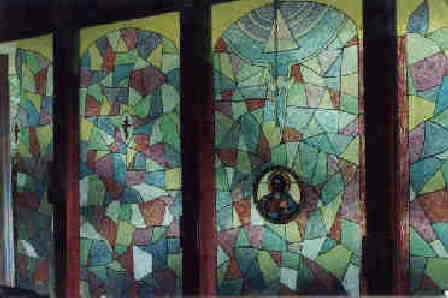| What are Icons? |
|
|
| What are Icons? |
|
|
|
Icons like the seven shown above are often used to detail the life of a Saint. For example, the Saint we named our Church after was St. Seraphim of Sarov. The Icons above are seven scenes from his saintly life here on earth. In the early days of the Christian Church, most people were not able to read and write. Fine educations were for a privileged few. The Church used Icons to teach the faithful about Holy people and events that shaped the Christian Church. There's a saying in Orthodoxy "Let the walls teach!" In other words, let the Icons inspire and teach the faithful about the Christian Faith! |
|
When you are in our Church, you can look up to the ceiling and see the Icon of Jesus Christ called the "Pantocrator", which means "Ruler & King". We are reminded by this that Jesus Christ is looking down from Heaven on us and giving us His blessing while we worship Him.
|
|
|
| Our walls at St. Seraphim's are truly teachers of the faith. This is one of the walls in our "Nave" that is dedicated to nothing but Icons. We have hand painted Icons, both old and new. The six framed Icons in the lower left hand side of the picture are scenes from the life of Jesus Christ, starting with the Annunciation - all the way through His Resurrection and Ascension into Heaven. At St. Seraphim's our walls and even our ceilings teach! |
 |
|
Our windows at St. Seraphim's teach as well. Here you see an Icon from the Ukraine of Jesus Christ. Descending upon Him is the Holy Spirit in the form of a Dove, as He did at the Baptism of Jesus Christ. Above, you see the Triangle, representing the Holy Trinity. Icons were approved for use in the Christian Church by the Seventh Ecumenical Council held in Nicea in the year 787 A.D. Icons are not "graven images", but "transfigured images" of Christ, the Virgin Mary, the Saints and Holy Events of the Christian Church. Icons are not worshiped, but venerated. You might see a soldier stationed overseas kiss a picture of his family. Clearly the soldier is not worshiping his family or the photo; but he is expressing love for his family. In the same manner, an Eastern Orthodox Christian that venerates an Icon is not worshiping the Icon, but showing their love for the Holy person, or event depicted on the Icon. Icons are like "Windows to Heaven"; they provide a spiritual focal point for our prayers. Icons serve to remind us that the Church Triumphant in Heaven is also invisibly present with us as we pray. As Eastern Orthodox Christians, we believe in the Communion of the Saints. When we worship the Holy Trinity during the Divine Liturgy, Icons of Jesus Christ, His Mother, and all the Saints surround us. This reminds us that we are not worshiping alone, but worshiping in the presence of the Holy Trinity and all the Saints, whom we regard as our brothers and sisters in Christ. Icons remind us that our God is not a God of the dead, but of the living. Our children are taught in elementary school to respect the American Flag. All Eastern Orthodox Christians are taught to respect Icons as well. An American Flag should not be kept on the floor, or in unsavory places. More importantly, an Icon depicting Jesus Christ, His Mother, or the Saints who are part of the eternal Kingdom of Jesus Christ, therefore should be afforded proper respect. One of the best uses for an Icon is to remind us to pray and center our lives around God.
|
|
Want an Icon for your refrigerator door? Click here to see what we have available
|